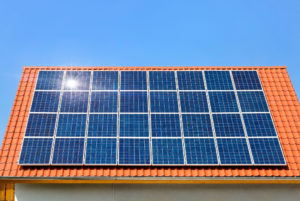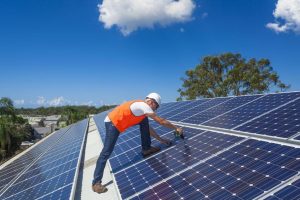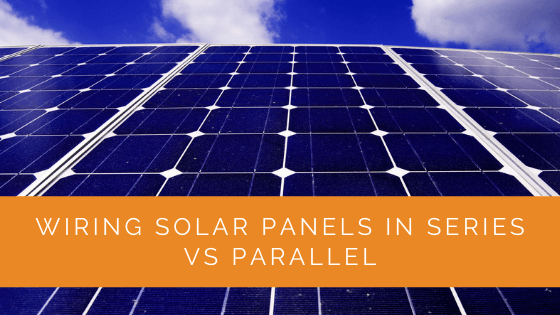Solar panels are used widely in many households today. They make a great alternative to generate electricity that is sustainable and efficient. However, did you know there are different ways to wire your solar panels?
There isn’t just one way to wire your solar panels. There are mainly two different ways to wire them. This structuring becomes even more crucial when there are multiple solar panels installed on your roof.
Also, did you know the performance of your panel depends on the way it gets wired? Yes, you read that right. Solar panel wiring is crucial to determine how effectively it can work and if there is a need for an inverter for its functioning.
Depending on the solar panel you install and the entire structure’s size, your solar panel technician can help you decide on the appropriate wiring. The wiring design is either series or parallel and sometimes a mix of both as well.
So how do you decide which is the suitable wiring system for your solar panel? Let us understand a few basic concepts to make the entire process easier for you.
Contents
- 1 Key Takeaways
- 2 Basic Concepts of Electricity
- 3 What Is Series Wiring in Solar Panels?
- 4 What Are the Benefits of Series Wiring?
- 5 What Are the Drawbacks of Series Wiring?
- 6 What Is Parallel Wiring in a Solar Panel?
- 7 What Are the Benefits of Parallel Wiring?
- 8 What Are the Drawbacks of Parallel Wiring?
- 9 Can Series and Parallel Wiring Operate Together?
- 10 Which Is the Best Solar Panel Wiring System for My Roof?
- 11 Why Do People Prefer Parallel Over Series Solar Panel Wiring?
- 12 Case Study: Optimizing Solar Panel Performance with Series and Parallel Wiring
- 13 Expert Insights From Our Solar Panel Installers About Wiring Solar Panels in Series vs Parallel
- 14 Experience Solar Excellence with Us!
- 15 Final Verdict
Key Takeaways
- Solar panels can be wired in two main ways: series and parallel. The choice of wiring impacts the performance and efficiency of the solar panel system.
- Series wiring increases voltage while maintaining the same amperage, making it suitable for those needing higher voltage in their solar panels. It is cost-effective and ideal for home installations.
- Parallel wiring allows for higher amperage and is beneficial for larger roofs with more panels. It ensures that even if one panel malfunctions, others continue to produce electricity, making it a reliable choice for uninterrupted power supply.
Basic Concepts of Electricity
Before getting deeper into the wiring details, you may need to be acquainted with a few technical terms. Well, not all terms are essential, but a few are.
- Voltage: This is the most commonly used term in the area of electrical energy. In simple words, voltage is the pressure needed to push the current through the loops of a wiring system that helps any appliance to function correctly.
So how does voltage affect a solar panel? If it’s a sunny day, the voltage required may be less since the temperature and the sun’s radiation will be comparatively lower. However, on a cold wintery day, the voltage produced by these panels will be much higher.
- Ohms: This is a unit that helps calculate resistance in an electrical system. So, if you lower the resistance of an electrical system, there are higher chances of the current flowing more efficiently.
- Amperage: It measures the electrical current in a solar panel and determines the volume of electrons that flows through its electrical system.
What Is Series Wiring in Solar Panels?
Solar panels that have series wiring provide only one path for the current to flow. In this structure, the positive terminal of one cell gets connected to the negative terminal of the next one, forming a closed-loop connection.
You can connect more than one panel through a series of wiring. Also, you may notice that the voltage of the panels adds together, but the amperage will remain unchanged.
For example: Connect two panels with a voltage of 40 volts and an amperage of 5 amps. The voltage will double and result in giving 80 volts to the panel, whereas the amperage remains the same, that is, five amps.
So if you are looking to increase the voltage of your solar panels, then series wiring will get the job. For the inverter to function, you need to balance the voltage of a panel. Hence, arranging them in a series will significantly affect the voltage of your panel.

What Are the Benefits of Series Wiring?
Series wiring is most commonly found in home solar panels. Below are a few upsides that you need to know before installing a wiring connection for your solar panels:
- Higher Voltage: Series wiring offers you a higher voltage for your panels and keeps the same amperage level.
- Easy Installation: It is easy to install wiring in series since it involves only a few wires.
- Inexpensive: As you can get the job done by a single long wire, you need not spend extra bucks on extra small cables. This method will save you money and hassles for installing.
- Voltage Drops: These wirings face voltage droppings less frequently as compared to others. Hence, you need to worry about the voltage fluctuation at your home, even during cold weather.
- Length of Wires: You can connect your solar panels in series without worrying much about the length of the wires. You can easily connect your series wire to the inverter without losing much electric power.
What Are the Drawbacks of Series Wiring?
Though there are some significant benefits of implementing series wiring, there are some drawbacks too. Below are a few cons of series wiring to a solar system:
- Dependency: In series wiring, one panel is dependent on the functionality of the other. If one circuit of the panel provides a lower performance, it affects the circuit’s productivity as a whole.
- Not Effective: With series wiring, your solar panel may risk offering an underperformed output of electric power. So you may experience an issue with electricity at your home due to the lower performance of the panel.
What Is Parallel Wiring in a Solar Panel?
Parallel wiring is a bit more complex compared to series wiring. A positive terminal is connected to another panel’s positive terminal in this solar panel wiring, whereas the negative end is attached to the other negative end. Unlike series wiring, these wirings aren’t dependent on each other.
Parallel wiring provides innumerable paths for the electric current to flow. Thus if one component of the wiring system gets broken, it does not harm the other parts of the circuit.
In parallel wiring, the amperage varies, and the voltage of the panels remains unchanged. With the help of parallel wiring, you can install more solar panels and maintain the voltage levels of the inverters.
You can connect your 12 V solar panels in a parallel wiring setup to produce maximum amperage and higher-quality electric power for charging your entire house.
Hence, if you have a big roof and are ready to spend some extra bucks on a top-notch wiring system, then parallels are meant for you.

What Are the Benefits of Parallel Wiring?
Here are a few advantages of implementing parallel wiring systems for your solar panels:
- High-Performance: As one panel isn’t dependent on the other, the functionality of one panel does not affect the performance of the other. So even if one panel is running the risk of breaking down, you need not worry about a power cut at home.
- Multiple Panels: Parallel wiring gets used to charge multiple panels. This way, you will be able to obtain maximum solar power with the help of innumerable panels.
- Higher Amperage: With the help of parallel wiring for your 12 V solar panels, you will be able to acquire a maximum amperage level.
What Are the Drawbacks of Parallel Wiring?
Mentioned below are a few disadvantages that you may experience with parallel wiring for solar panels:
- Heavy Wires: A solar installer may need to install heavier wires for your panels for a parallel wiring system. Also, you may need more wires to connect all the panels in a circuit to produce electricity.
- Expensive: With the use of heavier wires, the cost of installation also increases. You may have to spend extra bucks for smaller wires, and it becomes a challenge when the rooftop is vast.
- Space Limitation: Parallel wirings work best on a large roof with enough space to accommodate multiple panels.
Can Series and Parallel Wiring Operate Together?
It isn’t easy to get the required amperage and voltage from just one wiring system. So few of the solar technicians may advise you to combine both the wirings to get maximum power.
The voltage limit should be higher for a series connection, whereas, for a parallel system, the amperage level should be increased. Thus by combining both, you can avail a lower cost electrical wiring with the series combination and higher electrical power performance with a parallel combination.
Which Is the Best Solar Panel Wiring System for My Roof?
While both the wiring systems have their pros and cons, you need to consider which is the best suited depending on the application. If you are looking for a higher voltage out of your solar panel, then the series wiring is well-suited for you.
However, if you need higher amperage, then parallel wiring will do the job just right. Solar panels with series wiring are simple and easy to install. Also, if your inverter requires a higher voltage to operate, you may have to add series wiring for your panel.
However, with parallel wiring, you can install more solar panels that will produce more electrical energy while maintaining the voltage capacity of your panels. The primary reason why parallel wiring is a tad better option than a series is its higher performance.
Parallel wiring designs allow the current to flow even if one panel is not operational. You need to be concerned about electricity even if one panel is not functional. Each panel works individually without affecting the other.

Why Do People Prefer Parallel Over Series Solar Panel Wiring?
We are aware by now that a series of solar panels depends on each other to generate electricity. With one panel breaking down, it will affect the entire chain of wires in the circuit. It will adversely impact the flow of electricity through other panels.
If you have higher power requirements and need electricity 24*7 without interruption, then parallels are ideal. It is possible since if one panel is damaged, it will not affect the performance of the other panels.
So, by combining both, your panel will function more effectively and provide better results for your household’s power requirements.
Case Study: Optimizing Solar Panel Performance with Series and Parallel Wiring
Background
At Solar Panels Network USA, we are committed to delivering customized solar solutions that maximize energy efficiency and meet specific client needs. This case study explores the implementation of both series and parallel wiring systems to optimize the performance of a residential solar power system.
Project Overview
Our client, a homeowner with a moderate-sized roof and varied energy needs, sought to install a solar power system that could maximize energy production and provide reliable power supply. After a thorough assessment, we recommended a combination of series and parallel wiring to achieve the desired results.
Implementation
We began with a detailed site analysis to evaluate the roof space, shading patterns, and the household’s energy consumption. This assessment included measuring the roof dimensions and reviewing past electricity bills to determine the optimal system configuration.
Detailed Process
System Design and Planning: The system was designed to include 24 solar panels, divided into four strings of six panels each. Each string was wired in series to increase voltage, and then the strings were connected in parallel to enhance amperage and ensure reliability.
Installation: The solar panels were installed on the south-facing roof to maximize sun exposure. The series wiring of the panels ensured that the voltage was high enough to meet the inverter’s requirements, while the parallel connection ensured consistent power supply even if one panel was shaded or malfunctioning.
Optimization and Testing: After installation, the system underwent rigorous testing to ensure all connections were secure and functioning correctly. The hybrid wiring setup was optimized to balance voltage and amperage, providing efficient energy production.
Maintenance and Monitoring
A comprehensive maintenance and monitoring plan was established to ensure the system’s long-term efficiency:
Regular Inspections: Scheduled inspections were conducted to check for any signs of wear, damage, or debris on the panels and wiring. Regular maintenance helped in identifying potential issues early and maintaining optimal performance.
Performance Monitoring: The system’s performance was continuously monitored using advanced software, allowing the homeowner to track energy production and usage in real-time. This monitoring ensured that the system operated at peak efficiency.
Cleaning Procedures: The panels and wiring were cleaned regularly to remove dust and debris, which could reduce their efficiency. Non-abrasive materials and techniques were used to avoid damaging the system components.
Results
The implementation of the hybrid wiring system resulted in significant energy savings for the homeowner. The series and parallel combination ensured that the system generated enough electricity to cover approximately 80% of the household’s energy needs, leading to a substantial reduction in utility bills. The homeowner reported enhanced system performance and reliability, confirming the effectiveness of the wiring configuration.
Summary
This case study highlights the benefits of combining series and parallel wiring systems for solar panels. By balancing voltage and amperage, we optimized energy production and ensured a reliable power supply. Regular maintenance and monitoring further contributed to the system’s long-term performance, providing the homeowner with a sustainable and cost-effective energy solution.
Expert Insights From Our Solar Panel Installers About Wiring Solar Panels in Series vs Parallel
Choosing the right wiring system for your solar panels is crucial for maximizing efficiency and meeting your energy needs. Series wiring is great for increasing voltage, making it ideal for home installations where higher voltage is required.
Senior Solar Installer
Parallel wiring ensures that each panel operates independently, providing higher amperage and reliable power supply. This setup is particularly beneficial for larger installations with multiple panels and areas prone to shading.
Lead Solar Technician
Combining series and parallel wiring can optimize both voltage and amperage, offering a balanced solution for solar power systems. This hybrid approach is often recommended to achieve the best performance and reliability.
Solar System Engineer
Experience Solar Excellence with Us!
Trust in Solar Panels Network USA, where our seasoned experts deliver top-quality solar solutions for homes and businesses nationwide. With a legacy of countless successful installations and a commitment to sustainable energy, we’re your reliable partner in the solar journey. Ready for a brighter, eco-friendly future? Call us now at (855) 427-0058 and harness the power of the sun!
Final Verdict
By now, you will have a fair idea about the features of each wiring system. It is vital to analyze each of their advantages and drawbacks. Through this guide, you will figure out which wiring will be suitable for your solar panels.
If you need a higher-performance solar panel, a parallel is an excellent wiring option. However, you may need to spend extra on its installation. You can even combine the series and parallel wiring to enjoy the benefits of both.
Solar panels are long-term investments, and it would benefit if you prioritized your power and performance requirements before deciding on a wiring system.
About the Author
Solar Panels Network USA stands at the forefront of solar energy solutions, driven by a team of seasoned solar engineers and energy consultants. With over decades of experience in delivering high-quality solar installations and maintenance, we are committed to promoting sustainable energy through customer-centric, tailored solutions. Our articles reflect this commitment, crafted collaboratively by experts to provide accurate, up-to-date insights into solar technology, ensuring our readers are well-informed and empowered in their solar energy decisions.

